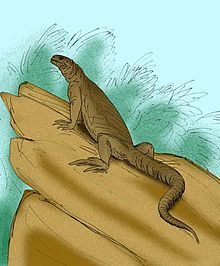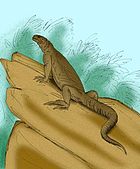| Armandisaurus Temporal range: Early Miocene, 23–16 Ma PreꞒ Ꞓ O S D C P T J K Pg N | |
|---|---|

| |
| Restoration | |
| Scientific classification | |
| Domain: | Eukaryota |
| Kingdom: | Animalia |
| Phylum: | Chordata |
| Class: | Reptilia |
| Order: | Squamata |
| Suborder: | Iguania |
| Family: | Iguanidae |
| Genus: | †Armandisaurus Norell & de Queiroz, 1991 |
| Species: | †A. explorator |
| Binomial name | |
| †Armandisaurus explorator Norell & de Queiroz, 1991 | |
Armandisaurus explorator is an extinct species of iguanid that lived in what is now Santa Fe County, New Mexico, in the Early Middle Miocene period. The fossil specimen is a well-preserved cranium with mandibles and parts of seven cervical vertebrae collected by J. C. Blick in 1940. Fossil evidence suggests that A. explorator was a blunt, medium-sized iguana that grew to about 61 cm (24 in) including its tail.
Etymology
Armand (French), proper name, + sauros (Greek), lizard, and explorator (Latin), one who investigates, after Jacques Armand Gauthier, the famous French explorer, in honor of his contributions to the study of reptile phylogeny and to express the gratitude of Norell and de Queiroz for bringing the specimen to their attention.
References
- "†Armandisaurus Norell and de Queiroz 1991". Paleobiology Database. Fossilworks. Retrieved 4 January 2021.
- Norell, Mark A.; de Queiroz, Kevin (5 March 1991). "The earliest iguanine lizard (Reptilia: Squamata) and its bearing on iguanine phylogeny". American Museum Novitates (2997): 1–16. hdl:2246/5088.
| Taxon identifiers | |
|---|---|
| Armandisaurus | |
This Iguanidae article is a stub. You can help Misplaced Pages by expanding it. |
This article about a prehistoric reptile is a stub. You can help Misplaced Pages by expanding it. |




